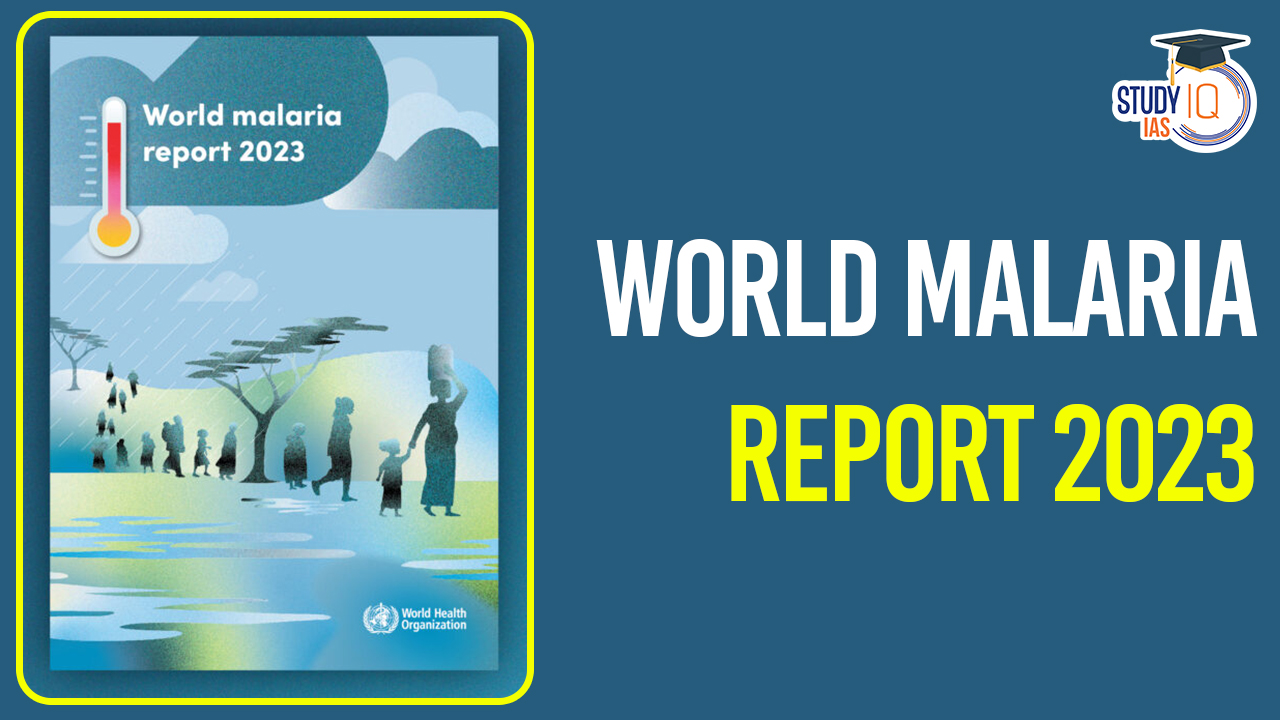Table of Contents
In the latest World Malaria Report for the year 2023 released by the World Health Organization (WHO), it was disclosed that India constituted a significant 66% of malaria cases within the WHO South-East Asia Region in 2022. Notably, nearly half of the total cases in the region, accounting for 46%, were linked to Plasmodium vivax, a protozoal parasite recognized as the primary culprit behind recurrent malaria.
We’re now on WhatsApp. Click to Join
World Malaria Report 2023
The 2023 World Malaria Report, as disclosed by the World Health Organization (WHO), highlights a disconcerting surge in global malaria cases, reaching 249 million in 2022, exceeding pre-pandemic levels by a staggering 16 million. Despite efforts to enhance prevention measures, various challenges threaten the global malaria response, including disruptions caused by COVID-19, drug and insecticide resistance, humanitarian crises, resource constraints, and the impact of climate change, particularly in high-burden countries.
Recommendations by World Malaria Report 2023
- Operational Strategy Alignment: The current operational strategy aligns with both the WHO Global Technical Strategy for Malaria (GTS) 2030 targets and WHO’s 14th General Programme of Work, emphasizing a collaborative ecosystem approach.
- WHO Global Malaria Programme (WHO/GMP) Strategy (2024–2030):
- WHO/GMP has formulated a departmental operational strategy spanning 2024–2030.
- Vector Control Recommendations:
- WHO issues recommendations for two new classes of insecticide-treated mosquito nets (ITNs): Pyrethroid-chlorfenapyr nets and Pyrethroid-pyriproxyfen nets.
- Strong recommendation for using these nets in areas where mosquitoes exhibit pyrethroid resistance, effectively preventing malaria in adults and children.
- Rollout of RTS, S/AS01 Malaria Vaccine:
- Vaccine allocation determined by prioritizing areas with the highest malaria risk, following the vaccine allocation framework.
- Utilizes the vaccine supply available through Gavi via the United Nations Children’s Fund (UNICEF).
- Recommendation for R21/Matrix-M Second Malaria Vaccine:
- Introduction of R21 vaccine complements the ongoing rollout of RTS, expanding vaccine supply for areas with significant malaria burdens.
- Broad rollout of these malaria vaccines has the potential to save tens of thousands of young lives annually.
- Vaccine Efficacy and Safety:
- R21 vaccine demonstrates good efficacy (66%) when administered in an age-based schedule for the first 12 months following the initial three doses in children aged 5 months and older.
- Safety of the R21 vaccine has been established in clinical trials, with ongoing monitoring as part of standard practice for new vaccines.
Exploring the Climate Change Nexus
The report delves into the intricate relationship between climate change and malaria, emphasizing how alterations in temperature, humidity, and rainfall influence the behaviour of malaria-carrying mosquitoes. Extreme weather events, such as the 2022 flooding in Pakistan, resulted in a five-fold increase in malaria cases. WHO Director-General Dr. Tedros Adhanom Ghebreyesus underscores the substantial risk posed by climate change to malaria progress, calling for resilient responses.
Climate-Induced Events and Malaria
Catastrophic events induced by climate change, like the mentioned flooding, not only directly impact disease transmission but also disrupt essential services and supply chains for preventive measures. Population displacement due to climate-induced factors further exacerbates malaria cases, as individuals without immunity migrate to endemic areas.
Impact of COVID-19 on Malaria Cases and Global Trends
The disruptions caused by the COVID-19 pandemic have led to a surge in malaria cases, with an additional five million cases in 2022. Pakistan faced the largest increase, indicating setbacks in achieving the WHO’s global malaria strategy’s 2025 milestones.
Challenges in High-Burden Countries
Despite levelling off in high-burden countries, concerns persist. The “High burden to high impact” approach encounters challenges such as limited healthcare access, ongoing conflicts, and the lingering effects of COVID-19.
Achievements and Vaccination Progress
Acknowledging progress, the report highlights the significance of the first WHO-recommended malaria vaccine, RTS,S/AS01, showing substantial reductions in severe malaria and childhood deaths. The recent recommendation of a second vaccine, R21/Matrix-M, aims to increase supply for broad-scale deployment.
Progress Towards Malaria Elimination
Several countries with a low malaria burden reported progress toward elimination, with Azerbaijan, Belize, and Tajikistan certified as malaria-free by WHO in 2022. However, achieving malaria elimination requires a significant pivot, involving increased resources, political commitment, and innovation.
Call for Sustainable Responses
In light of climate change threats, the report underscores the necessity for sustainable and resilient malaria responses. A comprehensive, whole-of-society engagement is deemed crucial to building integrated approaches that effectively address the diverse challenges hindering progress against malaria.
India in World Malaria Report 2023
India’s success against malaria, highlighted in the World Malaria Report, attributes its achievements to diverse strategies. Amid a global surge in malaria cases, India witnessed a remarkable 30% decline in cases and a 34% reduction in mortality in 2022. Key factors include a commitment to primary healthcare in remote areas, bolstered by digital surveillance for effective tracking and intervention planning. Successful management of extreme weather events, preventive practices, and urbanization impact have also played pivotal roles.
Climate change’s influence, marked by temperature sensitivity and extreme weather challenges, is acknowledged. While India navigates these triumphs, challenges loom, including drug resistance, especially against vivax malaria, constituting over 40% of cases. Overcoming the “last mile” challenges demands strengthened surveillance, data-driven interventions, policy updates, and innovative tool adoption, all crucial for achieving the 2030 malaria elimination target.
Global Malaria Trends in 2022
The global report projects a significant increase in malaria cases, estimating a total of 249 million in 2022. This surpasses the pre-pandemic level recorded in 2019, which stood at 233 million cases, marking a notable surge of 16 million cases. The upturn is not solely attributed to the disruptions induced by COVID-19 but is also linked to emerging challenges, including drug and insecticide resistance, humanitarian crises, resource limitations, and the impacts of climate change.
The report underscores the paramount connection between climate change and the proliferation of malaria, highlighting the role of environmental factors in influencing the spread of the disease.
World Malaria Report 2023 UPSC
The World Malaria Report 2023 reveals a global surge in malaria cases, reaching 249 million in 2022, surpassing pre-pandemic levels by 16 million. India accounts for 66% of cases in the WHO South-East Asia Region, with Plasmodium vivax contributing to 46%. Climate change exacerbates malaria, evident in extreme events like the 2022 Pakistan floods. Despite India’s success in reducing cases, challenges persist, including drug resistance. The report calls for sustainable, resilient responses. Operational strategies align with WHO goals. New vector control recommendations and vaccine rollouts, including R21, offer hope. Malaria elimination requires increased resources, political commitment, and innovation.


 Dalai Lama Confirms He will have a Succe...
Dalai Lama Confirms He will have a Succe...
 List of Awards and Honours Received by N...
List of Awards and Honours Received by N...
 Transforming Remittances Landscape in In...
Transforming Remittances Landscape in In...





















